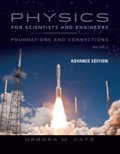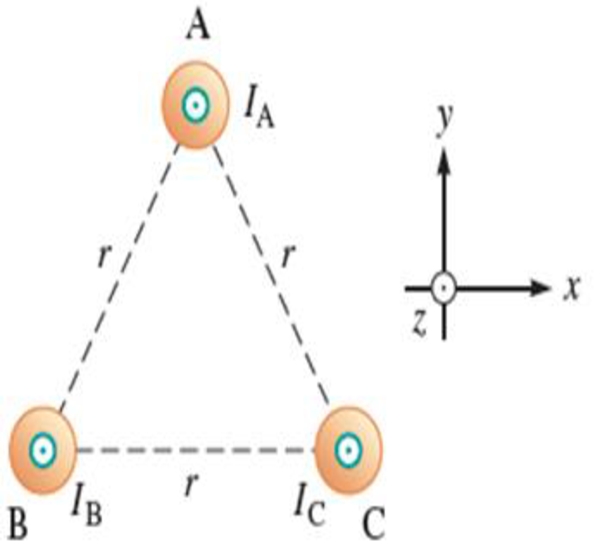
EBK PHYSICS FOR SCIENTISTS AND ENGINEER
16th Edition
ISBN: 8220100546716
Author: Katz
Publisher: CENGAGE L
expand_more
expand_more
format_list_bulleted
Concept explainers
Textbook Question
Chapter 30, Problem 64PQ
Consider the wires described in Problem 63. Find the magnetic force per unit length exerted on wire B.

Expert Solution & Answer
Want to see the full answer?
Check out a sample textbook solution
Students have asked these similar questions
Car P moves to the west with constant speed v0 along a straight road. Car Q starts from rest at instant 1, and moves to the west with increasing speed. At instant 5, car Q has speed w0 relative to the road (w0 < v0). Instants 1-5 are separated by equal time intervals. At instant 3, cars P and Q are adjacent to one another (i.e., they have the same position). In the reference frame o f the road, at instant 3 i s the speed o f car Q greater than, less than, or equal to the speed of car P? Explain.
Car P moves to the west with constant speed v0 along a straight road. Car Q starts from rest at instant 1, and moves to the west with increasing speed. At instant 5, car Q has speed w0 relative to the road (w0 < v0). Instants 1-5 are separated by equal time intervals.
Car P moves to the west with constant speed v0 along a straight road. Car Q starts from rest at instant 1, and moves to the west with increasing speed. At instant 5, car Q has speed w0 relative to the road (w0 < v0). Instants 1-5 are separated by equal time intervals. Sketch and label a vector diagram illustrating the Galilean transformation of velocities that relates velocity of car P relative to the road, velocity of car Q relative to road, and velocity of car Q relative to car P at instant 3. In the frame of car P, at instant 3 is car Q moving to the west, moving to the east, or at rest? Explain.
Chapter 30 Solutions
EBK PHYSICS FOR SCIENTISTS AND ENGINEER
Ch. 30.2 - Prob. 30.1CECh. 30.3 - Prob. 30.2CECh. 30.4 - Prob. 30.3CECh. 30.8 - Cosmic rays are high-energy charged particles...Ch. 30.9 - The Earths Van Allen belts (Fig. 30.34) are a...Ch. 30.10 - Prob. 30.6CECh. 30.10 - Prob. 30.7CECh. 30.12 - Prob. 30.8CECh. 30 - A yoga teacher tells her students to imagine their...Ch. 30 - Prob. 2PQ
Ch. 30 - Prob. 3PQCh. 30 - Prob. 4PQCh. 30 - Prob. 5PQCh. 30 - Copy Figure P30.6 and sketch the magnetic field...Ch. 30 - Prob. 7PQCh. 30 - Prob. 9PQCh. 30 - Figure P30.10 shows a circular current-carrying...Ch. 30 - Figure P30.11 shows three configurations of wires...Ch. 30 - Review A proton is accelerated from rest through a...Ch. 30 - An electron moves in a circle of radius r at...Ch. 30 - One common type of cosmic ray is a proton...Ch. 30 - Prob. 15PQCh. 30 - Prob. 16PQCh. 30 - Prob. 17PQCh. 30 - A Two long, straight, parallel wires are shown in...Ch. 30 - Prob. 19PQCh. 30 - Two long, straight, parallel wires carry current...Ch. 30 - Prob. 21PQCh. 30 - Two long, straight wires carry the same current as...Ch. 30 - Prob. 23PQCh. 30 - A wire is bent in the form of a square loop with...Ch. 30 - Prob. 25PQCh. 30 - A Derive an expression for the magnetic field...Ch. 30 - Prob. 27PQCh. 30 - Prob. 28PQCh. 30 - Prob. 29PQCh. 30 - Prob. 30PQCh. 30 - Prob. 31PQCh. 30 - Prob. 32PQCh. 30 - Prob. 33PQCh. 30 - Prob. 34PQCh. 30 - Normally a refrigerator is not magnetized. If you...Ch. 30 - Prob. 36PQCh. 30 - Prob. 37PQCh. 30 - The magnetic field in a region is given by...Ch. 30 - Prob. 39PQCh. 30 - Prob. 40PQCh. 30 - Prob. 41PQCh. 30 - The velocity vector of a singly charged helium ion...Ch. 30 - Prob. 43PQCh. 30 - Can you use a mass spectrometer to measure the...Ch. 30 - In a laboratory experiment, a beam of electrons is...Ch. 30 - Prob. 46PQCh. 30 - Prob. 47PQCh. 30 - Prob. 48PQCh. 30 - A proton and a helium nucleus (consisting of two...Ch. 30 - Two ions are accelerated from rest in a mass...Ch. 30 - Prob. 51PQCh. 30 - Prob. 52PQCh. 30 - A rectangular silver strip is 2.50 cm wide and...Ch. 30 - For both sketches in Figure P30.56, there is a...Ch. 30 - A 1.40-m section of a straight wire oriented along...Ch. 30 - Professor Edward Ney was the founder of infrared...Ch. 30 - Prob. 59PQCh. 30 - A wire with a current of I = 8.00 A directed along...Ch. 30 - Prob. 61PQCh. 30 - The triangular loop of wire shown in Figure P30.62...Ch. 30 - Prob. 63PQCh. 30 - Consider the wires described in Problem 63. Find...Ch. 30 - Prob. 65PQCh. 30 - Prob. 66PQCh. 30 - A Three parallel current-carrying wires are shown...Ch. 30 - Prob. 68PQCh. 30 - Prob. 69PQCh. 30 - Prob. 70PQCh. 30 - Prob. 71PQCh. 30 - Prob. 72PQCh. 30 - A circular coil 15.0 cm in radius and composed of...Ch. 30 - Prob. 74PQCh. 30 - Prob. 75PQCh. 30 - Prob. 76PQCh. 30 - Prob. 77PQCh. 30 - Two long, straight, current-carrying wires run...Ch. 30 - Prob. 79PQCh. 30 - Prob. 80PQCh. 30 - Prob. 81PQCh. 30 - Prob. 82PQCh. 30 - Two infinitely long current-carrying wires run...Ch. 30 - Prob. 84PQCh. 30 - Prob. 85PQCh. 30 - Prob. 86PQCh. 30 - A charged particle with charge q and velocity...Ch. 30 - Prob. 88PQCh. 30 - Prob. 89PQCh. 30 - A mass spectrometer (Fig. 30.40, page 956)...Ch. 30 - Three long, current-carrying wires are parallel to...Ch. 30 - Prob. 92PQCh. 30 - A current-carrying conductor PQ of mass m and...Ch. 30 - A proton enters a region with a uniform electric...
Knowledge Booster
Learn more about
Need a deep-dive on the concept behind this application? Look no further. Learn more about this topic, physics and related others by exploring similar questions and additional content below.Similar questions
- Just 5 and 6 don't mind 7arrow_forwardIn an electron gun, electrons are accelerated through a region with an electric field of magnitude 1.5 × 104 N/C for a distance of 2.5 cm. If the electrons start from rest, how fast are they moving after traversing the gun?arrow_forwardPlease solve and answer this problem correctly please. Thank you!!arrow_forward
- Please solve and answer this problem correctly please. Thank you!!arrow_forwarda) Use the node-voltage method to find v1, v2, and v3 in the circuit in Fig. P4.14. b) How much power does the 40 V voltage source deliver to the circuit? Figure P4.14 302 202 w w + + + 40 V V1 80 Ω 02 ΣΑΩ 28 A V3 + w w 102 202arrow_forwardPlease solve and answer this problem correctly please. Thank you!!arrow_forward
- You're on an interplanetary mission, in an orbit around the Sun. Suppose you make a maneuver that brings your perihelion in closer to the Sun but leaves your aphelion unchanged. Then you must have Question 2 options: sped up at perihelion sped up at aphelion slowed down at perihelion slowed down at aphelionarrow_forwardThe force of the quadriceps (Fq) and force of the patellar tendon (Fp) is identical (i.e., 1000 N each). In the figure below angle in blue is Θ and the in green is half Θ (i.e., Θ/2). A) Calculate the patellar reaction force (i.e., R resultant vector is the sum of the horizontal component of the quadriceps and patellar tendon force) at the following joint angles: you need to provide a diagram showing the vector and its components for each part. a1) Θ = 160 degrees, a2) Θ = 90 degrees. NOTE: USE ONLY TRIGNOMETRIC FUNCTIONS (SIN/TAN/COS, NO LAW OF COSINES, NO COMPLICATED ALGEBRAIC EQUATIONS OR ANYTHING ELSE, ETC. Question A has 2 parts!arrow_forwardThe force of the quadriceps (Fq) and force of the patellar tendon (Fp) is identical (i.e., 1000 N each). In the figure below angle in blue is Θ and the in green is half Θ (i.e., Θ/2). A) Calculate the patellar reaction force (i.e., R resultant vector is the sum of the horizontal component of the quadriceps and patellar tendon force) at the following joint angles: you need to provide a diagram showing the vector and its components for each part. a1) Θ = 160 degrees, a2) Θ = 90 degrees. NOTE: USE DO NOT USE LAW OF COSINES, NO COMPLICATED ALGEBRAIC EQUATIONS OR ANYTHING ELSE, ETC. Question A has 2 parts!arrow_forward
- No chatgpt pls will upvotearrow_forwardThe force of the quadriceps (Fq) and force of the patellar tendon (Fp) is identical (i.e., 1000 N each). In the figure below angle in blue is Θ and the in green is half Θ (i.e., Θ/2). A) Calculate the patellar reaction force (i.e., R resultant vector is the sum of the horizontal component of the quadriceps and patellar tendon force) at the following joint angles: you need to provide a diagram showing the vector and its components for each part. a1) Θ = 160 degrees, a2) Θ = 90 degrees. NOTE: USE ONLY TRIGNOMETRIC FUNCTIONS (SIN/TAN/COS, NO LAW OF COSINES, NO COMPLICATED ALGEBRAIC EQUATIONS OR ANYTHING ELSE, ETC. Question A has 2 parts!arrow_forwardNo chatgpt pls will upvotearrow_forward
arrow_back_ios
SEE MORE QUESTIONS
arrow_forward_ios
Recommended textbooks for you
 Physics for Scientists and Engineers: Foundations...PhysicsISBN:9781133939146Author:Katz, Debora M.Publisher:Cengage Learning
Physics for Scientists and Engineers: Foundations...PhysicsISBN:9781133939146Author:Katz, Debora M.Publisher:Cengage Learning
 Principles of Physics: A Calculus-Based TextPhysicsISBN:9781133104261Author:Raymond A. Serway, John W. JewettPublisher:Cengage Learning
Principles of Physics: A Calculus-Based TextPhysicsISBN:9781133104261Author:Raymond A. Serway, John W. JewettPublisher:Cengage Learning College PhysicsPhysicsISBN:9781305952300Author:Raymond A. Serway, Chris VuillePublisher:Cengage Learning
College PhysicsPhysicsISBN:9781305952300Author:Raymond A. Serway, Chris VuillePublisher:Cengage Learning College PhysicsPhysicsISBN:9781285737027Author:Raymond A. Serway, Chris VuillePublisher:Cengage Learning
College PhysicsPhysicsISBN:9781285737027Author:Raymond A. Serway, Chris VuillePublisher:Cengage Learning College PhysicsPhysicsISBN:9781938168000Author:Paul Peter Urone, Roger HinrichsPublisher:OpenStax College
College PhysicsPhysicsISBN:9781938168000Author:Paul Peter Urone, Roger HinrichsPublisher:OpenStax College

Physics for Scientists and Engineers: Foundations...
Physics
ISBN:9781133939146
Author:Katz, Debora M.
Publisher:Cengage Learning


Principles of Physics: A Calculus-Based Text
Physics
ISBN:9781133104261
Author:Raymond A. Serway, John W. Jewett
Publisher:Cengage Learning

College Physics
Physics
ISBN:9781305952300
Author:Raymond A. Serway, Chris Vuille
Publisher:Cengage Learning

College Physics
Physics
ISBN:9781285737027
Author:Raymond A. Serway, Chris Vuille
Publisher:Cengage Learning

College Physics
Physics
ISBN:9781938168000
Author:Paul Peter Urone, Roger Hinrichs
Publisher:OpenStax College
Magnets and Magnetic Fields; Author: Professor Dave explains;https://www.youtube.com/watch?v=IgtIdttfGVw;License: Standard YouTube License, CC-BY